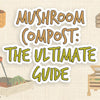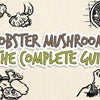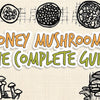Lion’s Mane Mushrooms: The Comprehensive Guide
Full and fluffy, energizing and full of pride. Living up to their name is Lion’s Mane mushrooms. The Lion’s Mane mushroom is an edible and medicinal mushroom belonging to the tooth fungus group (link).
Continue reading for a comprehensive guide to these mushrooms with their distinct taste and multitude of health benefits.
Not Much Time? Skip To What You’d Like To Learn….
-
History Of Lion’s Mane Mushrooms
-
5 Health Benefits of the Lion’s Mane Mushrooms
-
How To Use Lion’s Mane Mushroom As A Medicine
-
Foraging for Lion’s Mane Mushrooms
-
Cleaning Lion’s Mane Mushrooms
-
How To Preserve Lion’s Mane Mushrooms
-
How To Grow At Home
-
Lion’s Mane Mushroom Recipes

History Of Lion’s Mane Mushrooms
The formal name of Lion’s Mane mushrooms is hericium erinaceus. However, they are also known by many other names, such as hedgehog mushrooms, bearded tooth mushrooms, pom pom mushrooms, monkey head mushrooms, satyr’s beard mushrooms, deer tail mushrooms, and many more!
Originally reserved for royalty, the Lion’s Mane mushrooms taste similar to seafood. As well as being a culinary favorite the Lion’s Mane mushroom has been used in traditional Chinese medicine for its incredible health and cognitive benefits. The mushrooms are considered a nootropic (smart drug, or cognitive enhancer without the side effects).
5 Health Benefits of the Lion’s Mane Mushrooms
-
Prevent Dementia - Hericenones and erinacines are the two compounds found in Lion’s Mane mushrooms, both of these stimulate the growth of brain cells. As we age our brain begins to deteriorate, this explains why our cognitive ability decreases as we get older. On a study conducted on mice, it was found that Lion’s Mane mushrooms may be appropriate as a prevention or treatment of dementia (link) (link).
-
Relieve Anxiety and Depression - Chronic inflammation has been proven as a major cause of depression. Research on animals has shown that Lion’s Mane mushroom extracts have anti-inflammatory effects which could reduce symptoms of anxiety and depression (link).
-
Improve Focus - By reducing inflammation in the brain, the flow of blood improves and therefore allows more oxygen to the brain. Supplying the brain with more oxygen improves performance, concentration, and focus (link).
-
Manage Diabetes - Diabetes is a serious condition that causes a person’s blood sugar level to become too high (link). A study showed that Lion’s Mane mushrooms lowered the blood glucose level in rats. Therefore Lion’s Mane mushrooms could be used as an alternative treatment of diabetes (link).
-
Rich in Antioxidants - Lion’s Mane mushrooms are known to be rich in antioxidants. Antioxidants are vital to overall health as they stop free radicals and in turn protect our cells by lowering the risk of infection (link).
How To Use Lion’s Mane Mushroom As A Medicine

History - History suggests that Lion’s Mane mushrooms were used in traditional Chinese medicine specifically for treating stomach and digestive problems, including cancers. They were also used as a general restorative due to their anti-inflammatory, antibacterial, and immunomodulating properties (link).
Where To Find The Mushrooms - As well as foraging and being able to grow your own Lion’s Mane mushrooms, they are widely available from natural, health foods stores and online.
Alternative Ways To Consume - Due to the fish-like taste, many opt not to consume them in cooking. They are sold as capsules, powders, extracts, and coffee. Each will offer particular benefits, as well as suiting the taste of each buyer.
Dosage and Consumption - Depending on which form you buy your Lion’s Mane will depend on the dosage and consumption levels. Follow the instructions and directions as provided by the supplier.
Warnings -
-
Despite trials being conducted on mice and rats, there are very few trials on humans. More scientific research is certainly needed to understand the correlation between the mushrooms and their health benefits (link).
-
Lion's Mane supplements have little evidence or information about the safety of long-term use
-
There's some concern that Lion's Mane mushrooms may aggravate symptoms in people with allergies and asthma (link).
-
The majority of Lion’s Mane products will not be able to guarantee benefits due to the lack of scientific human evidence.
-
Due to the lack of human research, it is recommended to consult your physician before attempting to treat an illness with Lion’s Mane mushrooms.
Foraging for Lion’s Mane Mushrooms

When foraging we would always recommend using mushroom knife for ease of use, and a clean cut. Interested in learning more about mushroom knives? Click Here For The Complete Guide To Mushroom Knives
Where To Find Lion’s Mane mushrooms?
Country - Lion’s Mane mushrooms are native to North America, Europe, and Asia
Which Climate Do Lion’s Mane Mushrooms Grow In?
Climate - Lion’s Mane mushrooms tend to flourish in the fall, typically preferring a temperature of 65-75 degrees F. They prefer a humid, moist environment.
What Do I Look For To Find Lion’s Mane Mushrooms?
Environment - Lion’s Mane mushrooms can be found on dead or fallen wood, hardwood logs, stumps and standing trees (make sure you look up!). They are commonly found on maple, birch beech, and oak trees. Lion’s Mane mushrooms are a parasite, meaning they attack and kill living trees and feed off of the dead material (link).
How to Identify Lion’s Mane Mushrooms
Lion’s Mane mushrooms are very distinctive looking and easily identifiable. Very few mushrooms resemble Lion’s Mane mushrooms, those that do are also in the Hericium category. Fortunately, all species of Hericium are considered edible (link). This makes the Lion’s Mane mushroom a great one for new foragers.
-
Size - They tend to be around 3-10 inches wide and typically the same size tall.
-
Shape - Lion’s Mane is the only hericium species in eastern North America that is unbranched. The fruiting body of Lion’s Mane consists of numerous, icicle-like spines that point downward and taper to a point. Each spine is soft and typically half-an-inch to 2 inches in length. (link)
-
Smell - Lion’s Mane mushrooms do not have a distinctive smell when picked, compared to other mushrooms they have a relatively bland smell.
-
Color - Lion’s Mane mushrooms are white when young and mature to a yellowish color. When dried, the mushrooms turn a cream to rusty brown color.
WARNING: Never pick or eat wild mushrooms unless under the strict guidance of an expert.
Cleaning Lion’s Mane Mushrooms
Unless necessary it is advisable not to wash or wet the mushrooms as they are very porous. Simply brush with a mushroom brush or paint brush.
If your mushrooms do require extra cleaning, follow these steps:
Tools Required:
-
Soft mushroom brush or paint brush
-
Towel
Directions:
1. Gently brush the mushroom to remove dirt.
2. If you have to wash the mushroom hold under running water.
3. Dry them by squeezing the water out gently.
4. Slice or tear the mushroom apart, they have the texture of a cauliflower.
5. Place on a towel and wait until dry before cooking.
How To Preserve Lion’s Mane Mushrooms

Cultivated mushrooms can be stored in the fridge, it is recommended to use them within a week. Keep them in a paper bag no more than halfway full (link). If you won’t be using your mushrooms within the week, the best option for preserving them is to freeze them, this is due to the high water content.
Freezing Lion’s Mane Mushrooms
Before freezing Lion’s Mane Mushrooms it is best to sauté otherwise they become soggy due to their high water content. Be mindful of the oil you choose when cooking the mushrooms as they retain the flavor.
1. Clean the mushroom thoroughly
2. Slice or tear the mushroom to the desired size
3. Place skillet over medium heat and add the cooking oil
4. Add mushrooms and stir
5. Once the mushrooms are ready, they will appear golden brown
6. Remove from the heat and let cool
7. Once cool, place in a freezer bag, mark with date and type of mushroom
8. Freeze
For a more comprehensive guide to freezing have a look here
When ready to use remove the desired amount from the freezer and use from frozen. They are best used within 6-9 months.
Dehydrating Lion’s Mane Mushrooms
Dehydrating Lion’s Mane mushrooms is an alternative way to stop them from perishing. Dehydrated mushrooms can also be made into extracts which are commonly sold online as powders and capsules.
(link)
For a full guide on dehydrating mushrooms click the link here.
Tools Required:
-
Lion’s Mane mushrooms (1lb fresh mushrooms will produce one small sandwich bag of dehydrated mushrooms)
-
Baking sheet(s)
-
Clean kitchen towel
-
Oven
Directions:
1. Clean the mushrooms
2. Preheat oven to the lowest setting available
3. Lay mushrooms in a single layer on baking sheet(s)
4. Place in oven and allow to “cook” for around 8-10 hours, depending on the density of your mushrooms
5. Check after 1-2 hours of dehydrating for liquid formation on the pan. Drain any formed liquid. Check the mushrooms aren’t sticking to the pan if they are shuffle them around to unstick them
6. Place back in the oven to continue dehydrating. Check at least once more throughout the process
7. When the mushrooms are dry and brittle, they are done. Place in bag and seal tightly
How To Grow At Home

Lion’s Mane mushrooms are considered one of the easiest mushrooms to grow at home. But they need to be kept in a controlled environment as they are sensitive to rain and direct sunlight. They also bruise and damage easily, so need to be cared for whilst growing.
Growing Without a Kit (link):
Items Needed:
-
Lion’s Mane spawn
-
Substrate (hardwood or softwood sawdust, straw)
-
Large bucket
-
Polypropylene bag / polypropylene plastic
-
Pressure cooker
Directions:
1. Sterilizing the substrate
Fill the bucket with substrate. Soak in water for 2 hours. After 2 hours, drain excess water. Leave for 30 minutes. Excess water can cause contamination.
2. Transferring the substrate to plastic bags
Transfer the substrate to plastic bags making sure not to overfill. The tops of the bags should be loosely folded over.
3. Pressure cooking
Place the folded plastic bags into the tray of the pressure cooker and place the tray into the pressure cooker. Turn to high and wait for it to reach 250 degrees. Once you hear the hissing, sterilize for 2 hours. After the 2 hours, turn off the heat. Let cool for 6 hours inside the pressure cooker. Remove from the pressure cooker.
4. Planting the spawn
Gently crush and separate spawn in the packet. Add the spawn to the bags. Seal the bags and shake to mix the substrate and spawn.
5. Waiting Period
Leave in a room that is around 65 to 75 degrees, which is not directly exposed to the sun for about 3 weeks. After 3 weeks, the substrate should be covered with white fungi. Once this happens transfer to an airy location with traces of light. Make 5mm holes in the plastic bag. The mushrooms will grow through these holes. Keeping the mushrooms at high humidity is essential. Keep them moist but not wet by spraying twice a day.
6. Harvesting
After a few weeks, the mushrooms will begin to grow through the holes. When cutting use a sharp knife and be careful not to damage the spine. Make sure to harvest the mushrooms before they start turning pink.
Growing With A Kit:
There are also many kits available online for growing Lion’s Mane mushrooms. Most kits will include a block that has been completely colonized by Lion’s Mane mushroom mycelium. The instructions within the kit will explain how exactly to harvest the mushrooms. The conditions will be similar to as advised above.
Want to know our Top 10 Mushrooms Growing Kits? We have a full and comprehensive guide to the best growing kits and considerations before buying one too! Check out our Top 10 Mushroom Growing Kits Here.
Lion’s Mane Mushroom Recipes

Lion’s Mane mushrooms are renowned for their shellfish taste. Tasting remarkably similar to lobster once they have been cooked, like lots of mushrooms cooking simply brings out the flavor.
Pan Fried Lion’s Mane Mushrooms
Ingredients:
-
1/2 lb Lion’s Mane mushrooms
-
1 tbsp of olive oil
-
1 tbsp of butter
-
salt and pepper
Directions:
1. Prepare the Lion’s Mane mushrooms by gently brushing off the dirt or washing if necessary. Slice or tear into bite size pieces.
2. Heat oil in a large pan over medium to high heat.
3. Add mushrooms and cover, cook until mushrooms begin to dry out.
4. Add butter, season and continue to sauté for 2-3 mins until brown.
5. Serve immediately.
Lion’s Mane Mushroom Fish Cakes
Inspired by Mindful Glutton (link)
Ingredients:
-
1/2 lb Lion’s Mane Mushroom
-
2 tbsp olive oil
-
2 cloves garlic
-
2 tbsp Greek yogurt
-
1 tsp soy sauce
-
1 cup bread crumbs
-
1/4 cup diced onion
-
1 egg
-
splash of red or white vinegar
-
2-3 tbsp fresh chopped parsley
-
1 tsp smoked paprika
-
lemon juice from 1/4 lemon
-
3-4 tbsp coconut oil for frying
-
salt and pepper
For remoulade:
-
1/4 cup Greek yogurt
-
2 tbsp dijon mustard
-
1 tsp smoked paprika
-
juice of 1/4 lemon
Directions:
1. Dice Lion’s Mane mushrooms into large pieces. Drizzle in olive oil and roast in the oven with garlic at 350 degrees F for 30-40 mins. Turn halfway through. The mushrooms will shrink substantially as the water cooks out.
2. Create the remoulade by whisking yogurt, mustard, paprika, lemon juice, salt, and pepper in a bowl.
3. When ready put mushrooms and garlic mixture into food processor and pulse 4-5 times until broken down in smaller chunks.
4. Mix the egg, soy sauce, Greek yogurt, lemon juice, chopped parsley, paprika, vinegar, salt, and pepper in a separate bowl. Use a whisk to evenly mix the wet ingredients. Add breadcrumbs, onions and pulsed mushroom mixture.
5. Use a tablespoon to measure equal portions of fish cakes. With your hands form into cakes.
6. Warm coconut oil in a pan over medium heat and cook until lightly browned on both sides.
7. Finish with a sprinkle of salt and serve with remoulade.
Lion’s Mane Mushroom Pasta
Inspired by Mushroom Appreciation (link)
Ingredients:
-
1/2 lb Lion’s Mane mushrooms
-
3 tbsp butter
-
2 cups light cream
-
1/2 onion, chopped
-
2 cloves garlic, chopped
-
3 tbsp sauce flour
-
pasta of choice
Directions:
1. Cook pasta as per packet instructions.
2. Melt 1 tbsp of butter in a skillet over medium to high heat, add mushrooms cook until they have dried out.
3. Add onions and garlic, cook until soft and mushrooms have browned.
4. AAdd flour and the remaining butter, cook for several minutes stirring until the butter has melted.
5. Pour the cream over.
6. Turn down the heat and simmer until the cream is warmed through.
7. Serve immediately over cooked pasta.
Lion’s Mane Mushroom Tacos
Inspired by Veganesp (link)
Ingredients:
-
2 Lion's Mane mushrooms, cut into chunks
-
olive oil, for frying
-
flour tortillas
For the breading:
-
1/2 cup cornmeal
-
1/2 tsp garlic powder
-
a pinch dried oregano
-
1/2 tsp smoked paprika
-
salt and pepper
-
a pinch cumin
For the milk mixture
-
1/2 cup almond milk
-
2 tsp cornstarch
-
2 tbsp flour
Garnishes:
-
cabbage
-
chipotle Mayo
-
sriracha
Directions:
1. Heat the oil in a skillet over medium heat.
2. Mix the almond milk, flour, and cornstarch in a bowl and whisk to combine.
3. Mix the garlic powder, cornmeal, paprika, salt, pepper and cumin in a separate bowl.
4. Put the mushroom pieces into the milk mixture to coat completely, then place into the dry mix and coat evenly on all sides.
5. Place the breaded mushrooms into the pan and cook until tender and just brown. Reduce the heat to medium-low.
6. Divide the mix between the tortillas.
7. Top with cabbage, and chipotle mayo. Drizzle with sriracha.
Stir Fried Lion’s Mane Mushrooms
Inspired by Mercado Kitchen (link)
Ingredients:
-
2 tbsp butter
-
3 carrots, sliced thinly
-
1 white onion, diced
-
parsley, to garnish
-
salt and pepper
-
Lion’s Mane mushrooms, sliced into chunks
Directions:
1. Heat a skillet on medium heat, add the butter and onion, cook until browned.
2. Add the mushrooms and season with salt and pepper.
3. Stir in the carrots and sauté for around 5-7 minutes.
4. Serve with parsley.







Great information, would be awesome if you expanded to include extraction. I’ve tried to find information regard extraction in water with a pressure cooker, but not sure I should believe what I found on a forum recommending 14 hours in a pressure cooker, that seems outrageous to me to cook that long when some individuals boil in water to make a tea.
Chris